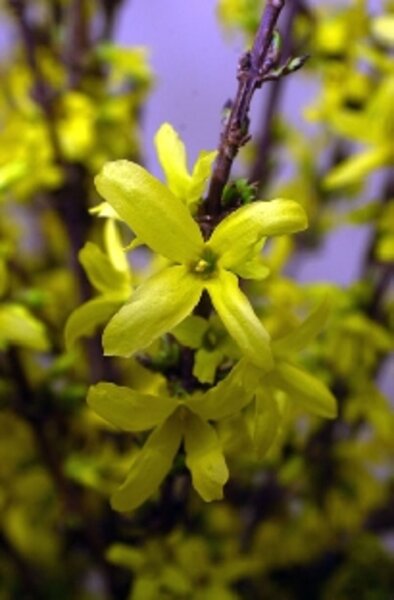A burst of spring blooms in the middle of winter
Loading...
In late February and early March, we are still in the clutches of winter where I live – the scenic Laurel Highlands of southwestern Pennsylvania. The weather is mercurial: One day a blizzard is raging; the following day temperatures rise and the snow begins to melt.
Just when winter releases its grip for a few days and the sun shines brightly, my impulsive nature convinces me to grab my rubber boots, a heavy wool sweater, and gloves.
I locate my garden clippers and a plastic bucket and set out to gather branches for an early spring arrangement. I simply ignore the date on the calendar and plan to usher in spring a month earlier by forcing the branches to bloom indoors.
My mission is easy to accomplish thanks to the generosity of a nearby neighbor who has several forsythia bushes growing along a wooden split rail fence. Pruning is good for the bush, because left unpruned, forsythias grow into unmanageable thickets with little flowering.
I convince myself that the slight breeze following me has a hint of the sweetness of an early spring. This reprieve from deep snow and frigid temperatures is a short-lived gift I gladly accept, because I know the landscape will soon be white again.
So walking down my country lane I don’t mind this false start to spring with snow melting as fast as vanilla ice cream on a summer day and muddy potholes ready for post-winter patching.
Three forsythia bushes line up along the fence. I cut the branches at a sharp angle and fill my bucket quickly. Normally, there should be water in the bucket to keep the branches from drying out until they are brought indoors. But since I am only a few minutes from home, I place them in the empty bucket and wrap them loosely in plastic so they don’t dry out.
Once home, I fill the bucket with cold water and allow the branches to rest for a couple days in the guest bedroom in a cool dark closet.
After two days, I fill three tall vases with cool water, recut the branches, arrange them in the vases, and place the bouquets near a sunny window. By late afternoon, the sun is streaming through the window and golden blossoms slowly begin to open and are transformed into flowering bouquets.
My odes to spring are placed strategically throughout the house to be enjoyed. The dining room table and my desk in the study are where daytime bouquets conjure up thoughts of spring’s awakening. A third arrangement of sunny yellow blossoms in my bedroom adds a cheerful note to my early rising.
When I hear the wind howling and see the snow whipping across the frozen ground at night, I feel smug as I glance at buds of gold bidding me a sweet good night. Winter has revisited, but sprays of forsythias cause me to pay it no heed.
Each area of the country differs for the best time to cut branches for forcing. I've found that the timetable varies according to the severity or mildness of the winter. In some areas, the forsythia could show a swelling of buds in midwinter while it blooms later in other regions of the country.
The best gauge is to check on the buds, the tight little nubbins encased in scales. When you see the buds beginning to swell, that will tell you that the flowering shrub is about to awake from its winter slumber.
Flowering crab apple, dogwood, and lilac branches are in my yard waiting to be forced into indoor blooms. These will be ripe for forcing later in March in Zone 5, where I live, but neighboring towns in Zone 6 will see the buds swell earlier.
For now, it is easy to ignore the official calendar date that heralds spring. Branches tipped in dainty yellow blossoms and dotted with bright green leaves tell me otherwise. Sometimes denial is a good thing.
Trees and shrubs that are good for forcing
On a day when temperatures are above freezing, choose branches with plump buds and cut them carefully from the tree or shrub with a sharp knife or pruners. Cut a few more branches than you think you’ll need in case some don’t absorb water.
Good choices include:
Shrubs -- Deutzia, Japanese or flowering quince, forsythia, honeysuckle, lilac, mock orange, European pussy willow, bridal wreath spiraea, viburnum, witch hazel.
Trees – Flowering almond, apple, beech, buckeye, crab apple, flowering cherry, dogwood, hawthorn, saucer magnolia, star magnolia, peach, pear, flowering plum, redbud, red maple.
(Editor's note: We invite you to visit the main page of the Monitor’s gardening site , where you can find many articles, essays, and blog posts on various garden topics.)





